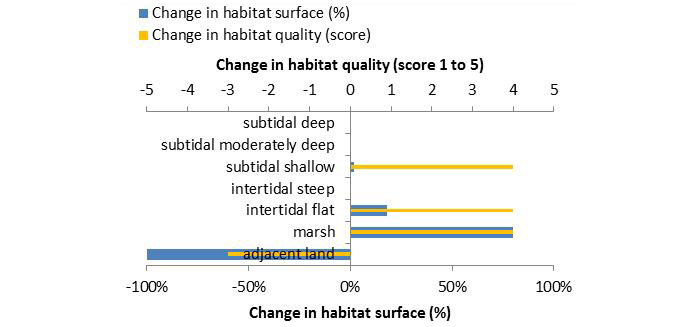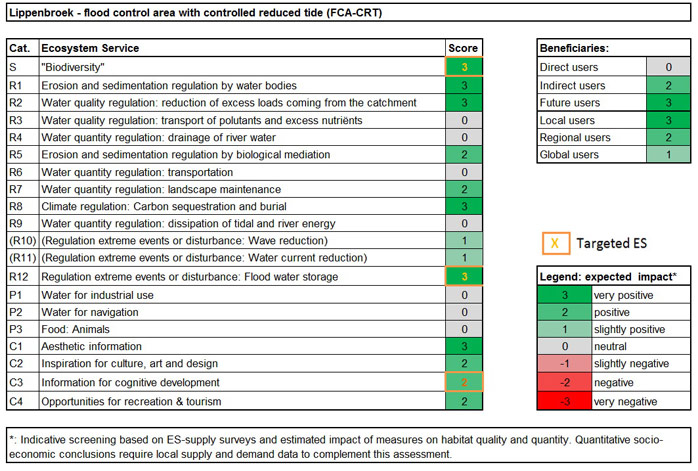

Disclaimer:
The authors are solely responsible for the content of this report. Material included herein does not represent the opinion of the European Community, and the European Community is not responsible for any use that might be made of it.
Back to overview measures
The measure Lippenbroek in the freshwater zone of the Scheldt estuary was about the creation of intertidal habitat by transforming adjacent land into mainly marshland with a high change in the habitat quality (Figure 21).
Before the CRT construction, Lippenbroek was an agricultural field (mainly maize and potatoes) with also small area of poplar planting and salix wood.
After construction an intertidal ecosystem with marsh and intertidal flat habitat developed. The share of marsh habitat increased in the years after the construction. In autumn 2009 around 80% of the area was covered by marsh habitat (based on (Maris et al. 2008b)). The other 20% was intertidal flat habitat and shallow water (channels and creeks).
Step 2: Expected impact on ecosystem services, compared with targeted ecosystem services, and expected impact on beneficiaries
More information about the methodology and the correct interpretation of the results could be found in the overall measures report (Saathoff et al. 2013).
(1) Overall expected impact on ES:
From the ES assessment it is concluded that this measure generates overall a positive expected impact for many ES, mainly for “biodiversity”, cultural service (Aesthetic information), and some regulating services (Erosion and sedimentation regulation (by water bodies); Water quality regulation: reduction of excess loads coming from the catchment; Climate regulation: Carbon sequestration and burial; Regulation extreme events or disturbance: Flood water storage).
Because the site is not directly linked with the estuary (sluice in between), some ES are not relevant such as Wave reduction and Water current reduction (indicated between brackets).
(2) Expected impact on targeted ES
The expected impact for the three development targets (“biodiversity”, “Regulation extreme events: flood water storage” and “Information for cognitive development”) is positive to very positive.
(3) Expected impact on beneficiaries
The expected impact for the different beneficiary groups is overall positive, with a very positive expected impact for future use and for local use.
Back to top
Lippenbroek: Flood Control Area with Controlled Reduced Tide (FCA-CRT)
Table of content
- 1. Description of measure
- 1a. Measure description
- 1b. Monitoring
- 1c. Monitoring results
- 2. Execution of main effectiveness criteria
- 2a. Effectiveness according to development targets of measure
- 2b. Impact on ecosystem services
- 2c. Degree of synergistic effects and conflicts according to uses
- 3. Additional evaluation criteria in view of EU environmental law
- 3a. Degree of synergistic effects and conflicts according to WFD aims
- 3b. Degree of synergistic effects and conflicts according to Natura 2000 aims
- 4. Crux of the matter
- 5. References
Additional information
for this measure:
No further information available.
for this measure:
No further information available.
Impact on ecosystem services
Step 1: Involved habitatsThe measure Lippenbroek in the freshwater zone of the Scheldt estuary was about the creation of intertidal habitat by transforming adjacent land into mainly marshland with a high change in the habitat quality (Figure 21).
Before the CRT construction, Lippenbroek was an agricultural field (mainly maize and potatoes) with also small area of poplar planting and salix wood.
After construction an intertidal ecosystem with marsh and intertidal flat habitat developed. The share of marsh habitat increased in the years after the construction. In autumn 2009 around 80% of the area was covered by marsh habitat (based on (Maris et al. 2008b)). The other 20% was intertidal flat habitat and shallow water (channels and creeks).
Step 2: Expected impact on ecosystem services, compared with targeted ecosystem services, and expected impact on beneficiaries
More information about the methodology and the correct interpretation of the results could be found in the overall measures report (Saathoff et al. 2013).
(1) Overall expected impact on ES:
From the ES assessment it is concluded that this measure generates overall a positive expected impact for many ES, mainly for “biodiversity”, cultural service (Aesthetic information), and some regulating services (Erosion and sedimentation regulation (by water bodies); Water quality regulation: reduction of excess loads coming from the catchment; Climate regulation: Carbon sequestration and burial; Regulation extreme events or disturbance: Flood water storage).
Because the site is not directly linked with the estuary (sluice in between), some ES are not relevant such as Wave reduction and Water current reduction (indicated between brackets).
(2) Expected impact on targeted ES
The expected impact for the three development targets (“biodiversity”, “Regulation extreme events: flood water storage” and “Information for cognitive development”) is positive to very positive.
(3) Expected impact on beneficiaries
The expected impact for the different beneficiary groups is overall positive, with a very positive expected impact for future use and for local use.

